Thirty Hertz Poinsettia
|
So, this one has been on hold for like two months because it being an extra-special build, I wanted some artwork done on the box. However, I haven't spent much time with my friend/art person lately (which I'm quite upset about), so it's been sitting, ready to assemble, on my shelf for this long. In light of us cracking the Blueberry, I said fuck it, I'll let you guys have it, because it was partially inspired by the Blueberry's sound.
So finally, it's done - the properly-tuned iteration of the first circuit I ever designed. I'm very happy to be sharing it with all of you, and I sincerely hope you choose to give it a try and enjoy playing it as much as I enjoyed developing it. Poinsettia was born from my frustration with many of the bass drives on the market. I find them, generally, to have far too much gain on tap, making them inarticulate and unimpressive, or otherwise turning one's tone into a muddy disaster/incoherent wall of bass. For example, I built myself an HBE Hematoma some time ago, and even after some modding, I still find that it is very dark and overly gainy. (I quit trying.) Don't get me wrong, it has its uses, but it isn't my idea of a really good bass drive (not to mention it sounds awful with a guitar). What I was looking for was a low-gain, well-controlled drive whose gain range was 100% useful (light grit at the bottom and no mud at the top), whose tone control didn't have useless settings (no woofy or ice-picky), and whose clipping characteristic was smooth and pleasant at all times. Since I had a difficult time finding that in a DIY-friendly package, I decided to make one myself. After a lot of breadboarding, I present to you, the Poinsettia. 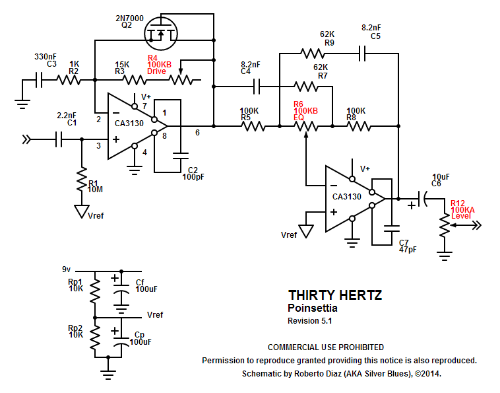 Schematic and circuit topology is definitely verified, vero should be verified as well. I haven't fired up the layout yet but I'd like to think I know what I'm doing  and I've checked/had it checked over a great many times. Feel free to peruse it before building it. and I've checked/had it checked over a great many times. Feel free to peruse it before building it.
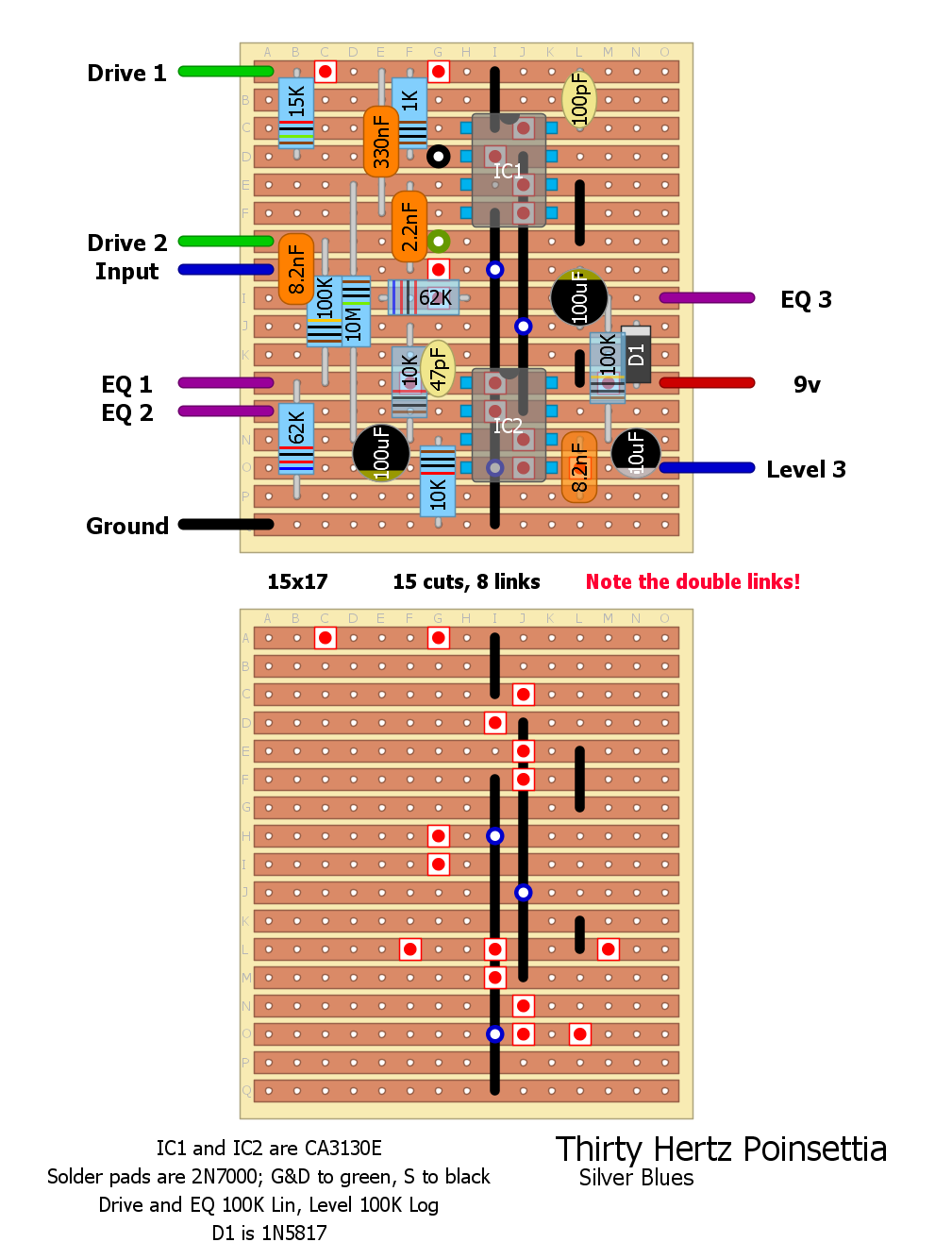 At the core of the circuit is a CA3130 MOSFET op-amp accompanied by MOSFET soft-clipping courtesy of a single 2N7000. I set the minimum gain of the op-amp at a slight breakup (via the 15K resistor) however the builder may choose to modify this or omit it as they see fit. Following the op-amp stage is an active tilt equalizer built around another CA3130. Some of you who saw the first revision may remember what this circuit used to look like - it (de-?)evolved from a 5-knob to a 4-knob to the current and final 3-knob configuration. Originally the circuit had a modified BMP tone stack with the AMZ presence mod, but I decided I didn't really like that as much as I could, so I axed it. After trying a variety of different passive tone stacks, I cleaned the slate and ventured into active EQ, and settled on this. I tuned the response so as to match the description I provided as closely as possible, not woofy or ice-picky anywhere on the knob. It has an asymmetric sweep, offering ±6dB in the bass and ±2.3dB in the treble, as shown below. (That note says "Pivot Freq. 322Hz. Stupid small pictures...) 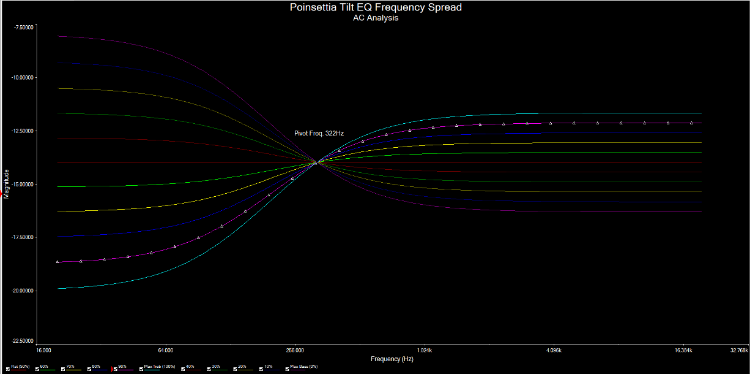 The tonality of this pedal is quite nice, I find. It is extremely dynamic and touch-sensitive, responding differently depending on your attack. At gain ranges from 0-30%, you get a nice light drive that ranges from a little breakup underneath fingerstyle, a little more so with a pick. 30-60% gets you a nice bark fingerstyle with a just a hint of sweet fuzzy undertones, and a solid clip with a pick. 60-100% is big sustaining drive, staying soft with fingers and hardening up with a pick. I find it has a bit of a universal mid emphasis, so watch yourself with very bright basses. Most testing was done with my bass strung with D'Addario Chromes and a custom variable capacitor tone control. Pretty much every setting, all the way up to pickup straight to jack, sounded great. My other bass with Dean Markley SR2000s, however, needed a front-panel mid cut to avoid sounding piercing. It might be an isolated incident, since SR2000s are known for being extremely mid-heavy, but something to note nevertheless. I don't foresee any such issues for the majority of applications. Something else I try and do with my designs is make them usable with guitar as much as possible. I don't go well out of my way for it, because I'm really mainly a bassist, but if after my tone-tuning the result is usable with a guitar I see it as a pleasant bonus. Despite my limited guitar skills, I can say that this circuit rips pretty hard with guitar. It's full of smooth, ballsy lead tones, and is decent as a rhythm drive. Please try it, I'm sure you'll like it! The gain range is, as I aimed for, entirely useful to a bassist IMO- it remains articulate at the maximum setting, but still has some push for some of the dirtier hard-rock kind of tones. Dialed back just a hair it allows you to get about as technical as you want without sullying note definition, while still retaining a reasonably hard drive. Although I chose to forego it, an interesting mod for those so inclined could be implemented with little fuss. Since this circuit is a slew-rate limited overdrive (other examples of this are many BJF pedals, to which this design shares a bit of structural similarity, and the Briggs Hummingbird), changing the value of the compensating capacitor in the clipping stage will modify the slew rate. Taking that capacitor to a switch gives you three options for slew rate, 47pF, ~103pF and ~227pF. Altering this capacitor changes the entire character of the drive. The 103pF setting is the standard setting, equivalent to the drive without this mod. The 47pF setting hardens up the drive tone and sharpens the treble of the tone control at all settings but flat. The 227pF setting does the opposite. I liked all the tones but didn't see myself using it that much - I was perfectly satisfied with the singular 100pF setting - however it's an easy mod that someone will enjoy enough to do, I'm sure. Below is the modified layout. I wouldn't do anything to the compensation cap on the EQ stage, as active equalizers tend to want as high of a slew rate as possible. It's not as critical here as, say, a headphone amp equalizer, but nevertheless I'd just leave that at 47pF. The Drive pot could also be substituted for an A, B or C250K for more gain if desired. You could even drop the gain pot to 50K and put a bigger series resistor in if you want more gain at the minimum setting. Guitarists may choose to raise the pivot frequency of the equalizer - this can be done by swapping out the 8.2nF capacitors; for example, 5.6nF moves it up to 472Hz, 4.7nF up to 563Hz, and 2.7nF up to 980Hz, and so on. Choose what sounds best to you if you're a tinker. 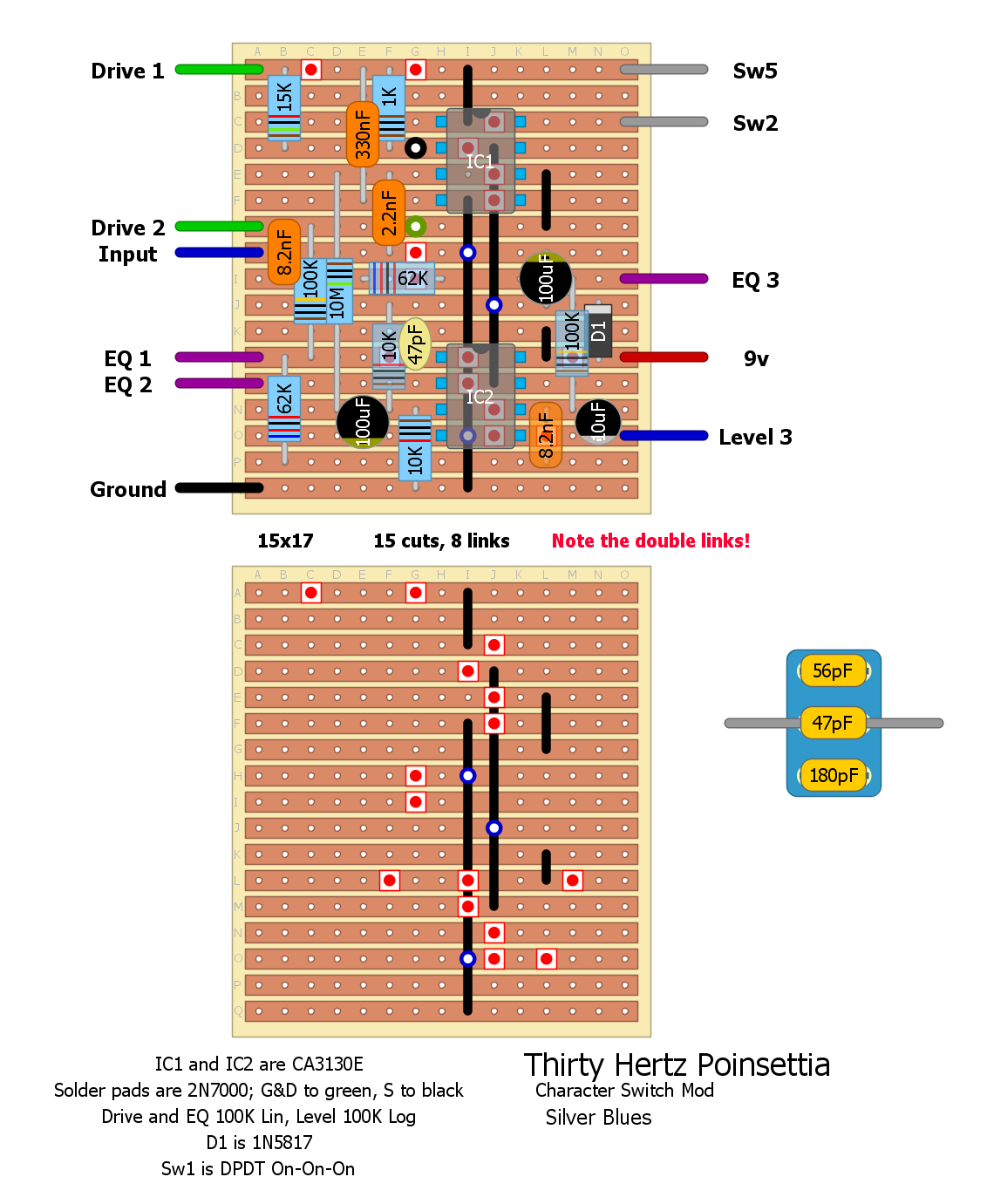 It's nice to get this out there, I really like the way it turned out and hopefully you guys will as well. Let me know what you think! Normally I'd include some pics of my original, but that's not done yet  so I will when it gets done. This'll also be up on FSB around that time as well. so I will when it gets done. This'll also be up on FSB around that time as well.
Also sorry for the tiny schematic and graph. I have no idea why the site won't let me post these two bigger than that yet my layouts are gigantic. Meh.
Through all the worry and pain we move on
|
|
Administrator
|
Beautiful, and sounds like a winner to me, but then again you and I think a lot a like in what we want form our OD's for bass
 . After the bbbod is built this will be #2. Can't wait, which sucks cause I'm still setting everything up from the move last week. Got my fingers crossed for next week, then I get back to work building, and power up the mesa for testing . After the bbbod is built this will be #2. Can't wait, which sucks cause I'm still setting everything up from the move last week. Got my fingers crossed for next week, then I get back to work building, and power up the mesa for testing . .
|
|
Fantastic, I really hope you like it!
 How'd the move go? Hope your new neighbors don't mind your testing How'd the move go? Hope your new neighbors don't mind your testing 
Through all the worry and pain we move on
|
|
Administrator
|
i'm sure i will. the move went ok, still have a TON of stuff to do, but i started getting things together. i've got 3 1/2 rooms done, have to redo kitchen, build a wall for my office/studio/lab, have furniture coming for the next week or so, and having a tree taken down cause it turns out its rotten, but other then that all is well. lol. my neighbors seem nice, so hopefully i won't make too much noise for them. one of the kids across the street saw me unloading half of my instruments (4 basses, 4 guitars) and it just stared in shock. he's going to freak when he seems me unloading the other guitars & basses, keyboard, and other assorted instruments, lol.
if all goes according to my plan, i should be back to normal by next week. plus i just got an order of Ge transistors from Russian today that have to be sorted. i think i'm slowly going insane now..... 
|
|
Great job Silver Blues! All the circuits I've built so far with a CA3130E IC (mostly BJFE/Bearfoot stuff) have been winners. I play guitar, but it sounds like your circuit would work for guitar too, so I may have a go at it when I have some time over the holidays for more experimental builds.
|
|
In reply to this post by rocket88
@Rocket Wow
 But yeah, that's good. Maybe the kid will become inspired and become a famous musician... or at least come here and start building some pedals. lol. But yeah, that's good. Maybe the kid will become inspired and become a famous musician... or at least come here and start building some pedals. lol.
@Frank Yeah I tested it a bit with my guitar, sounded good to me but what do I know  any and all feedback/mods appreciated. any and all feedback/mods appreciated.
Through all the worry and pain we move on
|
|
Administrator
|
Hey. Who knows I may end up with a protege.

|
|
Nice one! Thanks for sharing :)
I will breadboard it when the breadboard is free
check out my building blog at www.parasitstudio.se
|
|
Okay, so I finally got around to putting my original together. I'm pleased to say that the layout is VERIFIED. Sounds just as nice as I remember. I'll have pictures later though, because as it turns out my indicator is fried somehow... I swore it worked when I found it. Oh well, it's a $0.25 part. Had me worried for a second when I plugged it in and the thing didn't flash... but I heard the relay tick so knew immediately what the problem was.
Thing is either I order from eBay and wait a month for an LED or see if my local store has one and pay an exorbitant premium. 
Through all the worry and pain we move on
|
|
Thanks. I had printed out the layout a while back and intended to build it, so I'm glad that it's now verified. How would you describe the sound (same as your previous description)? I would use it with guitar BTW...
|
|
Yeah pretty much. I really like the tone. Let me know what you think.
Through all the worry and pain we move on
|
|
So I finally have build pics to show you guys! I think I have fixed (or at least reduced) the whistling issue I was having so I got around to taking some pictures to show off the final product (and these pictures aren't shit!).
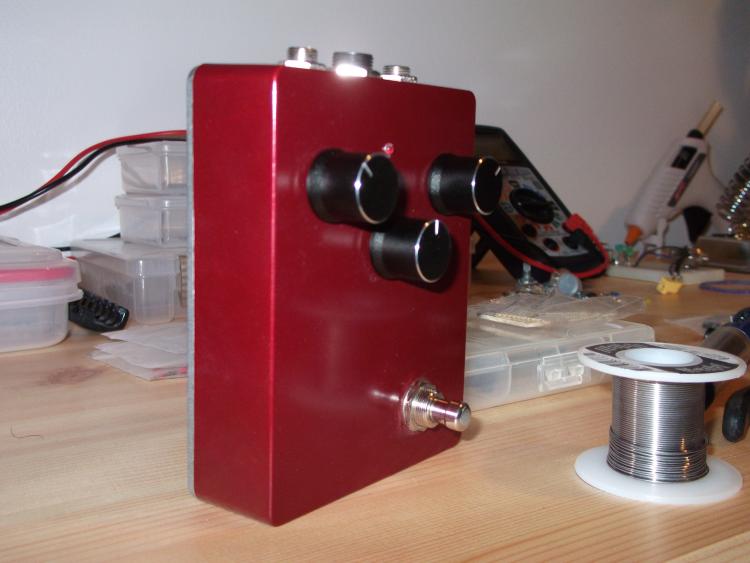 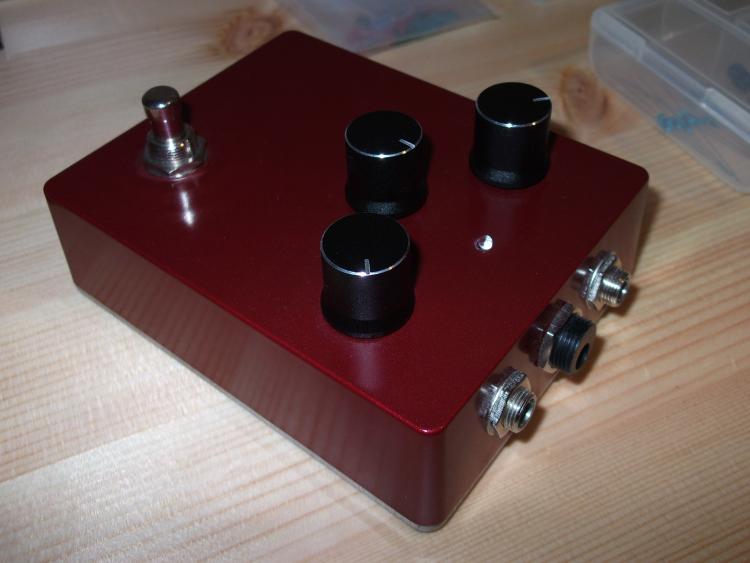 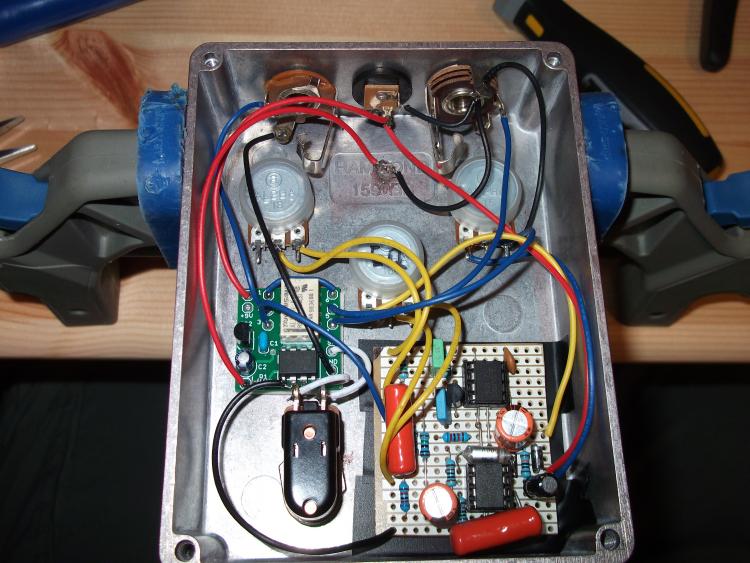 It's really a super transparent circuit (as cliché as that sounds); you get out of it what you put in it with more hair. I really like it on one of my basses and not so much on the other, and it sounds good with guitar so YMMV. I'll wait and see what people think before I put it up on FSB  The color is Mazda Copper Red from Pro-Form in case anyone's wondering (the color of my dad's car lol). I used one of Jack Orman's DPDT switch boards for the relay bypass. I ended up super-gluing the LED in because my hot glue pool failed  but it's in there pretty good now. And yes, the green LED with the red enclosure combined with the name of the circuit was a complete coincidence. but it's in there pretty good now. And yes, the green LED with the red enclosure combined with the name of the circuit was a complete coincidence.
Through all the worry and pain we move on
|
«
Return to Circuit designs
|
1 view|%1 views
| Free forum by Nabble | Edit this page |

